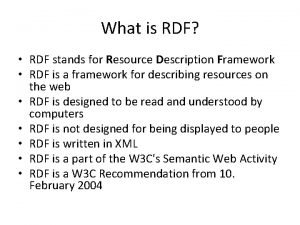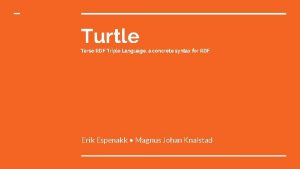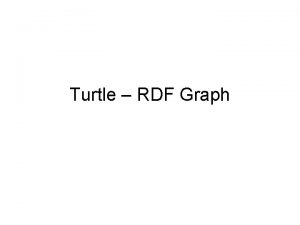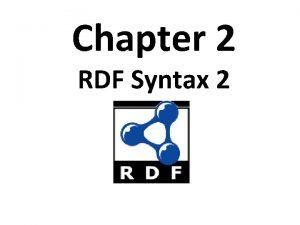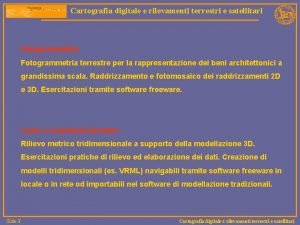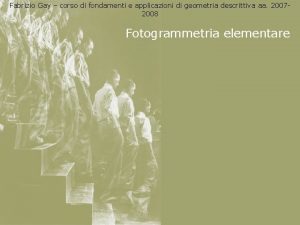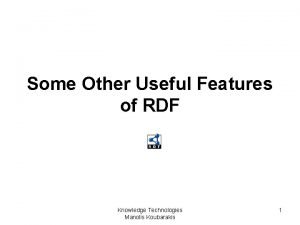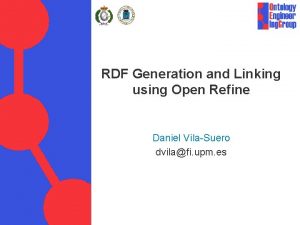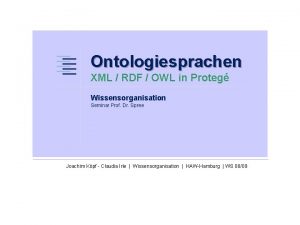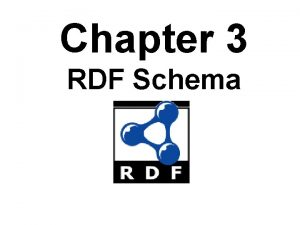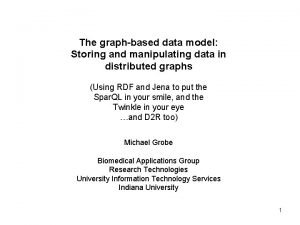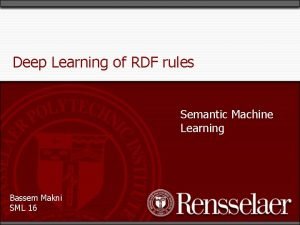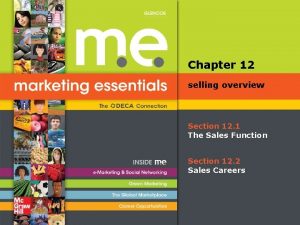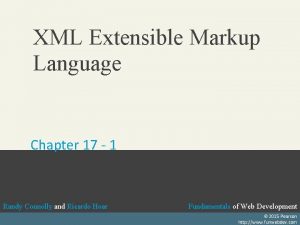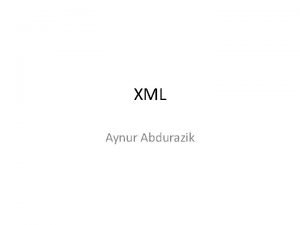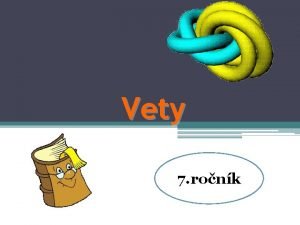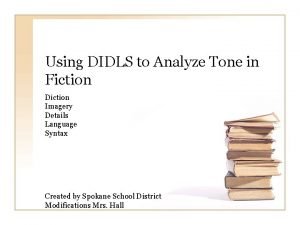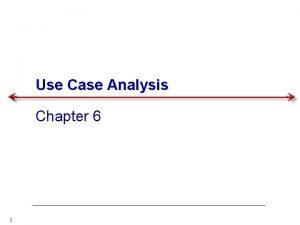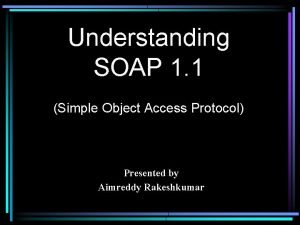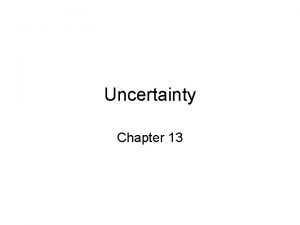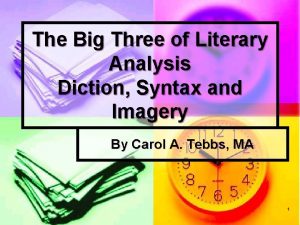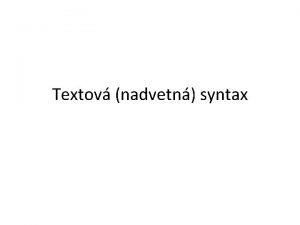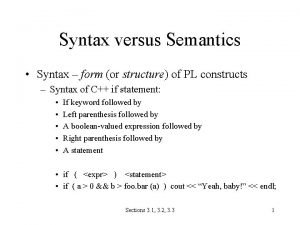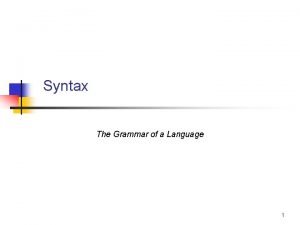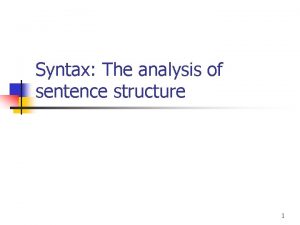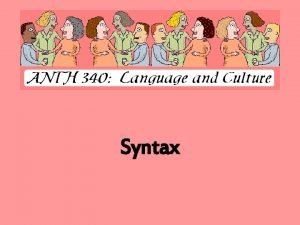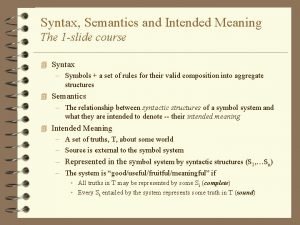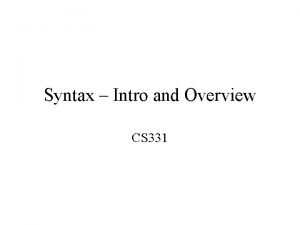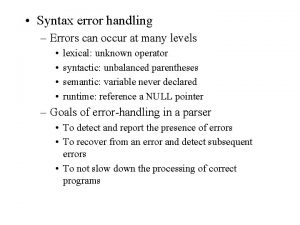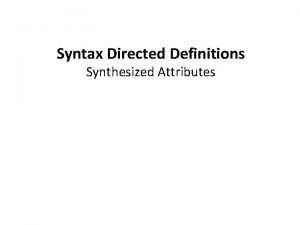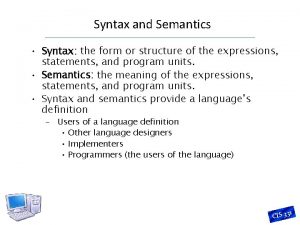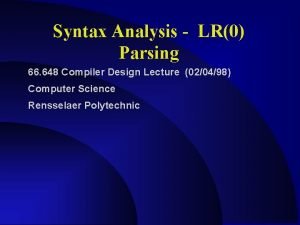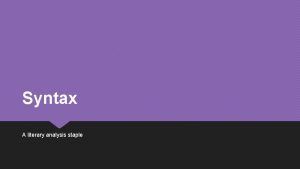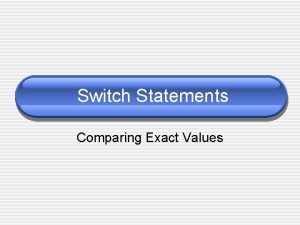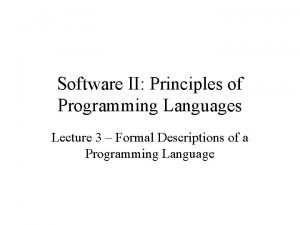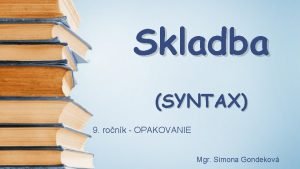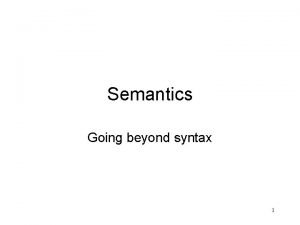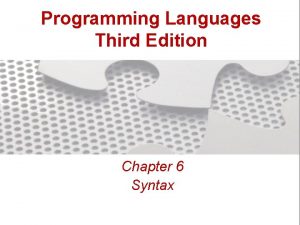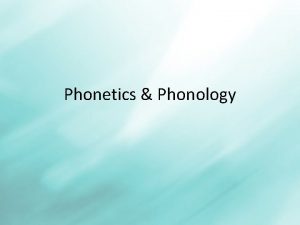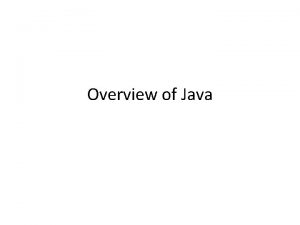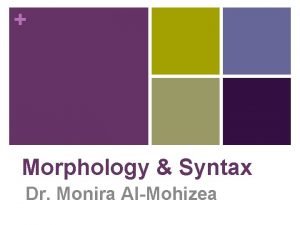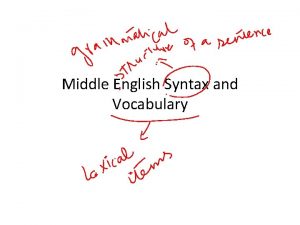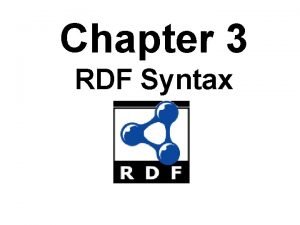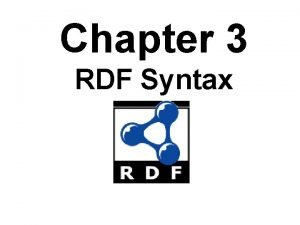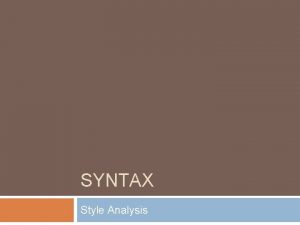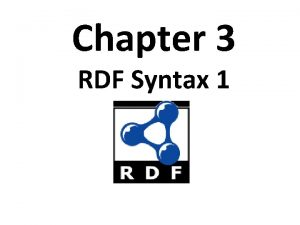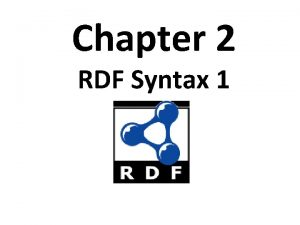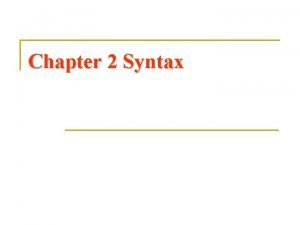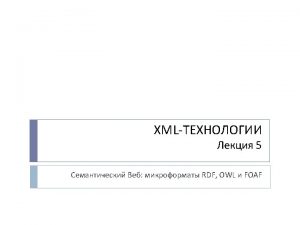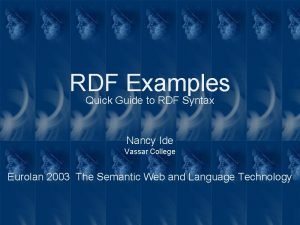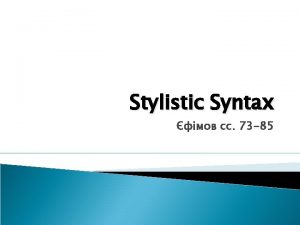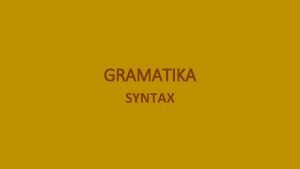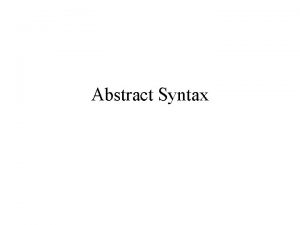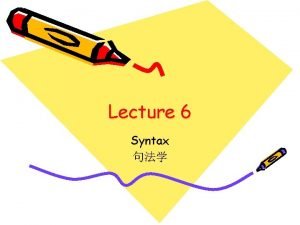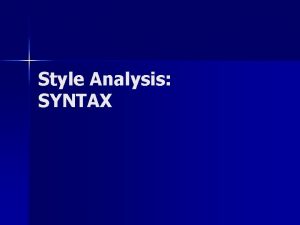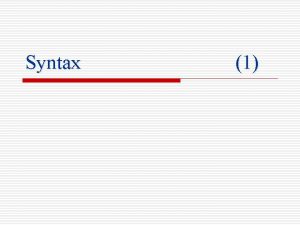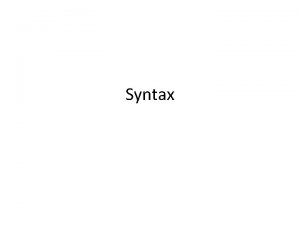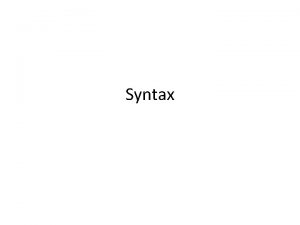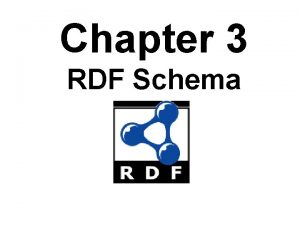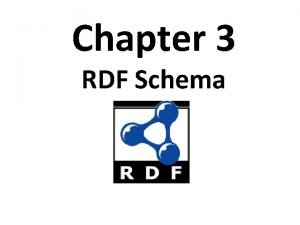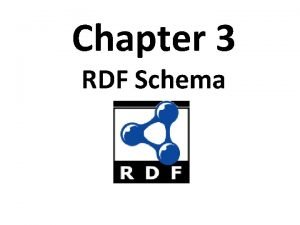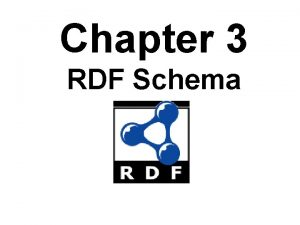Chapter 3 RDF Syntax RDF Overview l RDF
































































- Slides: 64

Chapter 3 RDF Syntax

RDF Overview l RDF Syntax -- the XML encoding l RDF Syntax – variations including N 3 l RDF Schema (RDFS) l Semantics of RDF and RDFS – – Axiomatic Semantics Operational semantics based on rules l Querying RDF via RQL and SPARQL

Introduction l Problem: – – XML is about data structures Their meaning (semantics) is not apparent to a machine l RDF – is more a data model than a language Is realized in many different formats l RDF – What does an XML document mean? define basic semantics RDFS and OWL define more RDF vocabulary for building rich data models l RDF remains domain independent

Example <academic. Staff. Member> Grigoris Antoniou </academic. Staff. Member> <professor> Michael Maher </professor> <course name="Discrete Mathematics"> <is. Taught. By> David Billington </is. Taught. By> </course> l What – – does this mean? Are professors also academic staff members? If someone teaches a course, are they an academic staff member? l Can’t say in XML, but can say so in RDFS

Example <course name="Discrete Mathematics"> <lecturer>David Billington</lecturer> </course> <lecturer name="David Billington"> <teaches>Discrete Mathematics</teaches> </lecturer> <teaching. Offering> <lecturer>David Billington</lecturer> <course>Discrete Mathematics</course> </teaching. Offering> l l Embedding of elements is just a syntactic constraint No meaning is defined It’s in the documentation or the mind of the viewer Does the machine have a mind?

Key RDF documents: standards http: //w 3. org/standards/techs/rdf

Key RDF documents: notes http: //w 3. org/standards/techs/rdf

Key RDF documents: drafts http: //w 3. org/standards/techs/rdf

The RDF Data Model l An RDF document is an unordered collection of statements, each with a subject, predicate and object (aka triples) l A triple can be thought of as a labelled arc in a graph l Statements describe properties of web resources l A resource is any object that can be referenced by a URI: – – – a document, a picture, a paragraph on the Web, … E. g. , http: //umbc. edu/~finin/cv. html predicate a book in the library, a real person (? ) subject isbn: //5031 -4444 -3333 … l Properties themselves are also resources (URIs) object

RDF Building Blocks l Resources – Things we can talk about, URIs l Properties – Special things that represent binary relations l Literal – data Strings, integers, dates, … xmldatatypes l Statements, – – l. A aka triples Subject Predicate Object or Subject Property Value graph defined by a collection of triples

URIs are a foundation l URI = Uniform Resource Identifier – "The generic set of all names/addresses that are short strings that refer to resources" – URLs (Uniform Resource Locators) are a subset of URIs, used for resources that can be accessed on the web l URIs look like “normal” URLs, often with fragment identifiers to point to a document part: – http: //foo. com/bar/mumble. html#pitch l URIs are unambiguous, unlike natural language terms – the web provides a global namespace – We assume references to the same URI are to the same thing

What does a URI mean? l Sometimes – – http: //umbc. edu/~finin/finin. jpg denotes a file We can use RDF to make assertions about the resource, e. g. , it’s an image and depicts a person with name Tim Finin, … l Sometimes – – concepts in the external world E. g. , http: //umbc. edu/ denotes a particular University located in Baltimore This is done by social convention l Cool – URIs denote a web resource URIs don’t change http: //www. w 3. org/Provider/Style/URI

Simple RDF Example dc: Title “Intelligent Information Systems on the Web” http: //umbc. edu/ ~finin/talks/idm 02/ dc: Creator bib: Aff http: //umbc. edu/ bib: name “Tim Finin” bib: email “finin@umbc. edu”

RDF Data Model is a Graph l l l Graphs only allow binary relations Higher arity relations must be “reified” (i. e. , turned into objects) Represent give(John, Mary, Book 32) as three binary relations all involving a common object, give. Event 32 – giver(give. Event 45 , John ) – recipient( give. Event 45 , Mary ) – gift(give. Event 45 , Book 32 ) When using RDF, this has to be part of your vocabulary design This is a price we have to pay for using a simple representation based on binary relations

RDF Statements l RDF has one predefined scheme (syntax and semantics) for the reification of RDF statements themselves l Needed to support assertions about triples – – – Document 32 asserts “John gave Mary a book” Tom believes John gave Mary a book “John gave Mary a Book” has 0. 33 probability

XML encoding for RDF <rdf: RDF xmlns: rdf="http: //www. w 3. org/1999/02/22 -rdf-syntax-ns#" xmlns: dc="http: //purl. org/dc/elements/1. 1/" xmlns: bib="http: //daml. umbc. edu/ontologies/bib/"> <rdf: Description about="http: //umbc. edu/~finin/talks/idm 02/"> <dc: title>Intelligent Information Systems on the Web </dc: Title> <dc: creator> <rdf: Description > <bib: name>Tim Finin</bib: Name> <bib: email>finin@umbc. edu</bib: Email> <bib: aff resource="http: //umbc. edu/" /> </rdf: Description> </dc: creator> </rdfdescription> </rdf: RDF>

XML encoding for RDF <rdf: RDF xmlns: rdf="http: //www. w 3. org/1999/02/22 -rdf-syntax-ns#" xmlns: dc="http: //purl. org/dc/elements/1. 1/" xmlns: bib="http: //daml. umbc. edu/ontologies/bib/"> <rdf: Description about="http: //umbc. edu/~finin/talks/idm 02/"> <dc: title>Intelligent Information Systems on the Web </dc: Title> <dc: creator> <rdf: Description > <bib: name>Tim Finin</bib: Name> <bib: email>finin@umbc. edu</bib: Email> Note that the document is a single RDF element <bib: aff resource="http: //umbc. edu/" /> several namespaces: which has attributes defining • One for the rdf vocabulary </rdf: Description> • One for the Dublin Core vocabulary </dc: creator> • One for the Bib vocabulary </rdf: Description> </rdf: RDF>

XML encoding for RDF <rdf: RDF xmlns: ="http: //www. w 3. org/1999/02/22 -rdf-syntax-ns#" xmlns: dc="http: //purl. org/dc/elements/1. 1/" xmlns: bib="http: //daml. umbc. edu/ontologies/bib/"> <Description about="http: //umbc. edu/~finin/talks/idm 02/"> <dc: title>Intelligent Information Systems on the Web </dc: Title> • An empty prefix means that this is <dc: creator> the default namespace for the <Description > document • Any non-literal symbols without a <bib: name>Tim Finin</bib: Name> prefix are in this namespace <bib: email>finin@umbc. edu</bib: Email> • E. g. , <Description> <bib: aff resource="http: //umbc. edu/" /> </Description> </dc: creator> </Description> </rdf: RDF>

XML encoding for RDF <rdf: RDF xmlns: rdf="http: //www. w 3. org/1999/02/22 -rdf-syntax-ns#" xmlns: dc="http: //purl. org/dc/elements/1. 1/" xmlns: bib="http: //daml. umbc. edu/ontologies/bib/"> <rdf: Description about="http: //umbc. edu/~finin/talks/idm 02/"> <dc: title>Intelligent Information Systems on the Web </dc: Title> <dc: creator> <rdf: Description > <bib: name>Tim Finin</bib: Name> • Here’s the general way to introduce a “named <bib: email>finin@umbc. edu</bib: Email> subject” about /> which we want to assert some <bib: aff resource="http: //umbc. edu/" properties and values </rdf: Description> • We name subjects by referring to their URI • An element in the description tag specify a property </dc: creator> and its value </rdf: Description> </rdf: RDF>

Descriptions l Every description makes a statement about a resource l There are different ways: – An about attribute: referencing an existing resource <rdf: Description rdf: about=“http…”> … – An id attribute: creating a new resource <rdf: Description rdf: ID=“foo 3456”> … – Without a name: creating an anonymous resource <rdf: Description> …

rdf: about versus rdf: ID l An – – element rdf: Description has an rdf: about attribute indicating that the resource has been “defined” elsewhere An rdf: ID attribute indicating that the resource is defined l Formally, there is no such thing as “defining” an object in one place and referring to it elsewhere – Sometimes is useful (for human readability) to have a defining location, while other locations state “additional” properties l. A Description with neither produces a “blank node” – It can not be referred to either from outside the rdf document

XML encoding for RDF <rdf: RDF xmlns: rdf="http: //www. w 3. org/1999/02/22 -rdf-syntax-ns#" xmlns: dc="http: //purl. org/dc/elements/1. 1/" xmlns: bib=“http: //daml. umbc. edu/ontologies/bib/” xmlns: xsd=“http: //www. w 3. org/2001/XMLSchema#” > <rdf: Description about="http: //umbc. edu/~finin/talks/idm 02/"> <dc: title>Intelligent Information Systems on the Web </dc: Title> <dc: creator> <rdf: Description > <bib: name>Tim Finin</bib: Name> <bib: email>finin@umbc. edu</bib: Email> • dc: title is the property (or predicate) <bib: aff resource="http: //umbc. edu/" • It’s value is the/>literal string “Intelligent Information </rdf: Description> Systems on the Web” </dc: creator> • By default we assume the datatype is string • <ex: age rdf: datatype="&xsd; integer> 22 </ex: age> </rdf: Description> • <ex: age> “ 27”^^xsd: integer> 22 </ex: age> </rdf: RDF>

XML encoding for RDF • The value of creator is defined by the nested RDF <rdf: RDF xmlns: rdf="http: //www. w 3. org/1999/02/22 -rdf-syntax-ns#" • The nameless description produces a “blank node” xmlns: dc="http: //purl. org/dc/elements/1. 1/" • In this case, “a thing with a name=“Tim Finin” and …” xmlns: bib=“http: //daml. umbc. edu/ontologies/bib/” • This style of XML encoding is called “striped” xmlns: xsd=“http: //www. w 3. org/2001/XMLSchema#” > <thing> <property> <rdf: Description about="http: //umbc. edu/~finin/talks/idm 02/"> <thing> <property> <dc: title>Intelligent Information Systems on the Web </dc: Title> <dc: creator> <rdf: Description > <bib: name>Tim Finin</bib: Name> <bib: email>finin@umbc. edu</bib: Email> <bib: aff resource="http: //umbc. edu/" /> </rdf: Description> </dc: creator> </rdf: Description> </rdf: RDF>

XML encoding for RDF • Note the “self closing” tag <rdf: RDF xmlns: rdf="http: //www. w 3. org/1999/02/22 -rdf-syntax-ns#" • The value of the bib: aff property is a resource, not a xmlns: dc="http: //purl. org/dc/elements/1. 1/" string xmlns: bib=“http: //daml. umbc. edu/ontologies/bib/” • Every resource has a URI, every URI refers to a resource xmlns: xsd=“http: //www. w 3. org/2001/XMLSchema#” > • How would this be interpreted? <description about="http: //umbc. edu/~finin/talks/idm 02/"> <bib: aff> http: //umbc. edu/ </bib: aff> <dc: title>Intelligent Information Systems on the Web </dc: Title> <dc: creator> <description > <bib: name>Tim Finin</bib: Name> <bib: email>finin@umbc. edu</bib: Email> <bib: aff resource="http: //umbc. edu/" /> </description> </dc: creator> </description> </rdf: RDF>

N triple representation l. RDF can be encoded as a set of triples. <subject> <predicate> <object>. <http: //umbc. edu/~finin/talks/idm 02/> <http: //purl. org/dc/elements/1. 1/Title> "Intelligent Information Systems on the Web". _: j 10949 <http: //daml. umbc. edu/ontologies/bib/Name> "Tim Finin". _: j 10949 <http: //daml. umbc. edu/ontologies/bib/Email> "finin@umbc. edu". _: j 10949 <http: //daml. umbc. edu/ontologies/bib/Aff> <http: //umbc. edu/>. _: j 10949 <http: //www. w 3. org/1999/02/22 -rdf-syntax-ns#type><Description>. <http: //umbc. edu/~finin/talks/idm 02/> <http: //purl. org/dc/elements/1. 1/Creator> _: j 10949. <http: //umbc. edu/~finin/talks/idm 02/> <http: //www. w 3. org/1999/02/22 -rdf-syntax-ns#type> <Description>. Note the gensym for the anonymous node _: j 10949

Triple Notes l RDF triples have one of – <URI> – <URI> <quoted string> two forms: l Triples are also easily mapped into logic – <subject> <predicate> <object> becoming: l <predicate>(<subject>, <object>) l With type(<S>, <O>) becoming <O>(<S>) – Example: l subclass(man, person) ; Note: we’re not l sex(man, male) ; showing the actual l domain(sex, animal) ; URIs for clarity l man(adam) l age(adam, 100) l Triples – are easily stored and managed in DBMS Flat nature of a triple a good match for relational DBs

N 3 notation for RDF l N 3 is a compact notation for RDF that is easier for people to read, write and edit. l Aka notation 3, developed by TBL himself. l Translators exist between N 3 and the XML encoding, such as the web form on – http: //www. w 3. org/Design. Issues/Notation 3. html l So, it’s just “syntactic sugar” l But, XML is largely unreadable and even harder to write

N 3 Example @prefix rdf: http: //www. w 3. org/1999/02/22 -rdf-syntax-ns#. @prefix dc: http: //purl. org/dc/elements/1. 1/. @prefix bib: http: //daml. umbc. edu/ontologies/bib/. < http: //umbc. edu/~finin/talks/idm 02/ > dc: title "Intelligent Information Systems on the Web" ; dc: creator [ bib: Name "Tim Finin“ ; bib: Email finin@umbc. edu ; bib: Aff: "http: //umbc. edu/" ]. thing Note special [ … ] syntax for an anonymous node prop 1 = value ; prop 2 = value ; … propn = value.

Example of University Courses <rdf: RDF xmlns: rdf="http: //www. w 3. org/1999/02/22 -rdf-syntax-ns#" xmlns: xsd="http: //www. w 3. org/2001/XLMSchema#" xmlns: uni="http: //example. org/uni-ns"> <rdf: Description rdf: about="949318"> <uni: name>David Billington</uni: name> <uni: title>Associate Professor</uni: title> <uni: age rdf: datatype="&xsd: integer">27<uni: age> </rdf: Description>

Example of University Courses (2) <rdf: Description rdf: about="CIT 1111"> <uni: course. Name>Discrete Maths</uni: course. Name> <uni: is. Taught. By>David Billington</uni: is. Taught. By> </rdf: Description> <rdf: Description rdf: about="CIT 2112"> <uni: course. Name>Programming III</uni: course. Name> <uni: is. Taught. By>Michael Maher</uni: is. Taught. By> </rdf: Description> </rdf: RDF>

Data Types for Literals l Data types are used in programming languages to allow interpretation l In RDF, typed literals are used l You can specify this with a special ^^ syntax (“David Billington”, http: //example. org/age, “ 27”^^http: //www. w 3. org/2001 XMLSchema#integer) l or using the rdf: datatype attribute <uni: age rdf: datatype="&xsd: integer">27<uni: age>

Data Types for Literals l ^^-notation indicates the type of a literal l In practice, the most widely used data typing scheme will be the one by XML Schema – But the use of any externally defined data typing scheme is allowed in RDF documents l XML Schema predefines a large range of data types – E. g. Booleans, integers, floating-point numbers, times, dates, etc.

XMLSchema Datatypes http: //www. w 3. org/TR/xmlschema-2/

The rdf: resource Attribute l The relationships between courses and lecturers (in the example) were not formally defined but existed implicitly via the use of the same name l The use of the same name may just be a coincidence l We can denote that two entities are the same using the rdf: resource attribute – Later we’ll see that we can use an owl: same. As assertion l By design, RDF explicitly rules out the common unique name assumption found in many representation systems

The rdf: resource Attribute <rdf: Description rdf: about="CIT 1111"> <uni: course. Name>Discrete Mathematics </uni: course. Name> <uni: is. Taught. By rdf: resource="949318"/> </rdf: Description> <rdf: Description rdf: about="949318"> <uni: name>David Billington</uni: name> <uni: title>Associate Professor</uni: title> </rdf: Description>

Referencing Externally Defined Resources l Refer to the externally defined resource CIT 1111 using http: //example. org/uni-ns#CIT 1111 as the value of rdf: about l Assuming that example. org/uni-ns is the URI where the definition of CIT 1111 is found l A description with an ID defines a fragment URI, which can be used to reference the defined description

Nested Descriptions: Example <rdf: Description rdf: about="CIT 1111"> <uni: course. Name>Discrete Maths</uni: course. Name> <uni: is. Taught. By> <rdf: Description rdf: ID="949318"> <uni: name>David Billington</uni: name> <uni: title>Associate Professor</uni: title> </rdf: Description> </uni: is. Taught. By> </rdf: Description>

Nested Descriptions l Descriptions may be defined within other descriptions l Other courses, such as CIT 3112, can still refer to the new resource with ID 949318 l Although a description may be defined within another description, its scope is global

RDF types <rdf: Description rdf: about="CIT 1111"> <rdf: type rdf: resource="&uni: Course"/> <uni: course. Name>Discrete Mathematics</uni: course. Name> <uni: is. Taught. By rdf: resource="949318"/> </rdf: Description> <rdf: Description rdf: about="949318"> <rdf: type rdf: resource="&uni: Lecturer"/> <uni: name>David Billington</uni: name> <uni: title>Associate Professor</uni: title> </rdf: Description> l RDF has a trivial type system l RDFS and OWL extend it greatly

RDF types, another syntax <rdf: Description rdf: ID="CIT 1111"> <rdf: type rdf: resource="http: //example. org/unins#course"/> <uni: course. Name>Discrete Maths</uni: course. Name> <uni: is. Taught. By rdf: resource="#949318"/> </rdf: Description> <rdf: Description rdf: ID="949318"> <rdf: type rdf: resource="http: //example. org/unins#lecturer"/> <uni: name>David Billington</uni: name> <uni: title>Associate Professor</uni: title> </rdf: Description>

RDF types, yet another Syntax <uni: course rdf: ID="CIT 1111"> <uni: course. Name>Discrete Mathematics</uni: course. Name> <uni: is. Taught. By rdf: resource="949318"/> </uni: course> <uni: lecturer rdf: ID="949318"> <uni: name>David Billington</uni: name> <uni: title>Associate Professor</uni: title> </uni: lecturer> l This abbreviated syntax is very common

Abbreviated Syntax l So we have two simplification rules: 1. Childless property elements within description elements may be replaced by XML attributes 2. For description elements with a typing element we can use the name specified in the rdf: type element instead of rdf: Description l These rules create syntactic variations of the same RDF statement – They are equivalent according to the RDF data model, although they have different XML syntax

Abbreviated Syntax: Example <rdf: Description rdf: ID="CIT 1111"> <rdf: type rdf: resource="http: //example. org/unins#course"/> <uni: course. Name>Discrete Maths <uni: course. Name> <uni: is. Taught. By rdf: resource="#949318"/> </rdf: Description>

Application of First Simplification Rule <rdf: Description rdf: ID="CIT 1111" uni: course. Name="Discrete Maths"> <rdf: type rdf: resource="http: //example. org/unins#course"/> <uni: is. Taught. By rdf: resource="#949318"/> </rdf: Description>

Application of 2 nd Simplification Rule <uni: course rdf: ID="CIT 1111" uni: course. Name="Discrete Maths"> <uni: is. Taught. By rdf: resource="#949318"/> </uni: course>

Container Elements l Collect a number of resources or attributes about which we want to make statements as a whole l E. g. , we may wish to talk about the courses given by a particular lecturer l The content of container elements are named rdf: _1, rdf: _2, etc. – Alternatively rdf: li l Containers seem a bit messy in RDF, but are needed

Three Types of Container Elements l rdf: Bag an unordered container, allowing multiple occurrences – E. g. , members of the faculty board, documents in a folder l rdf: Seq an ordered container, which may contain multiple occurrences – E. g. , modules of a course, items on an agenda, an alphabetized list of staff members (order is imposed) l rdf: Alt a set of alternatives – E. g. the document home and mirrors, translations of a document in various languages

Example for a Bag <uni: lecturer rdf: ID="949352" uni: name="Grigoris Antoniou" uni: title="Professor"> <uni: courses. Taught> <rdf: Bag> <rdf: _1 rdf: resource="#CIT 1112"/> <rdf: _2 rdf: resource="#CIT 3116"/> </rdf: Bag> </uni: courses. Taught> </uni: lecturer>

Example for Alternative <uni: course rdf: ID="CIT 1111" uni: course. Name="Discrete Mathematics"> <uni: lecturer> <rdf: Alt> <rdf: li rdf: resource="#949352"/> <rdf: li rdf: resource="#949318"/> </rdf: Alt> </uni: lecturer> </uni: course>

Rdf: ID Attribute for Container Elements <uni: lecturer rdf: ID="949318" uni: name="David Billington"> <uni: courses. Taught> <rdf: Bag rdf: ID="DBcourses"> <rdf: _1 rdf: resource="#CIT 1111"/> <rdf: _2 rdf: resource="#CIT 3112"/> </rdf: Bag> </uni: courses. Taught> </uni: lecturer>

Bags and Seqs are never full! l RDF’s semantics is “open world”, so… – There is no possibility ”to close” the container, to say: “these are all elements, there are no more” – RDF is a graph, so: there is no way to exclude the possibility that there is another graph somewhere that describes additional members l Collections for groups with only the specified members are described via a predefined collection vocabulary of the types: – rdf: List, rdf: first, rdf: rest, rdf: nil

RDF Lists CIT 2112 is exclusively taught by teachers 949111, 949352, 949381 <rdf: Description rdf: about="CIT 2112"> <uni: is. Taught. By> <rdf: List> <rdf: first><rdf: Description rdf: about="949111"/></rdf: first> <rdf: rest> <rdf: List> <rdf: first><rdf: Description rdf: about="949352"/></rdf: first> <rdf: rest> <rdf: List> <rdf: first><rdf: Description rdf: about="949318"/></rdf: first> <rdf: rest><rdf: Description rdf: about="&rdf; nil"/></rdf: rest> </rdf: List> </uni: is. Taught. By> </rdf: Description> Yuck!

RDF Lists Syntactic Sugar The the rdf: parse. Type attribute helps <rdf: Description rdf: about="CIT 2112"> <uni: is. Taught. By rdf: parse. Type="Collection"> <rdf: Description rdf: about="949111"/> <rdf: Description rdf: about="949352"/> <rdf: Description rdf: about="949318"/> </uni: is. Taught. By> </rdf: Description>

Reification l l l Sometimes we wish to make statements about other statements We must be able to refer to a statement using an identifier RDF allows such reference through a reification mechanism which turns a statement into a resource

Reify l Etymology: l Date: Latin res thing 1854 l to regard (something abstract) as a material or concrete thing

Wikipedia: reification (computer science) Reification is the act of making an abstract concept or low-level implementation detail of a programming language accessible to the programmer, often as a first-class object. For example, – – The C programming language reifies the low-level detail of memory addresses. The Scheme programming language reifies continuations (approximately, the call stack). In C#, reification is used to make parametric polymorphism implemented as generics a first-class feature of the language. …

Reification Example <rdf: Description rdf: about="#949352"> <uni: name>Grigoris Antoniou</uni: name> </rdf: Description> reifies as <rdf: Statement rdf: ID="Statement. About 949352"> <rdf: subject rdf: resource="#949352"/> <rdf: predicate rdf: resource="http: //example. org/unins#name"/> <rdf: object>Grigoris Antoniou</rdf: object> </rdf: Statement>

Reification l l rdf: subject, rdf: predicate and rdf: object allow us to access the parts of a statement The ID of the statement can be used to refer to it, as can be done for any description We write an rdf: Description if we don’t want to talk about a statement further We write an rdf: Statement if we wish to refer to a statement

RDF Critique: Properties l Properties are special kinds of resources – Properties can be used as the object in an object-attribute-value triple (statement) – They are defined independent of resources l This possibility offers flexibility l But it is unusual for modelling languages and OO programming languages l It can be confusing for modellers

RDF Critique: Binary Predicates l RDF – – uses only binary properties This is a restriction because often we use predicates with more than two arguments But binary predicates can simulate these l Example: – referee(X, Y, Z) X is the referee in a chess game between players Y and Z

RDF Critique: Binary Predicates l We – – introduce: a new auxiliary resource chess. Game the binary predicates ref, player 1, and player 2 l We can represent referee(X, Y, Z) as:

RDF Critique: : Reification l The reification mechanism is quite powerful l It appears misplaced in a simple language like RDF l Making statements about statements introduces a level of complexity that is not necessary for a basic layer of the Semantic Web l Instead, it would have appeared more natural to include it in more powerful layers, which provide richer representational capabilities

RDF Critique: Graph Representation l The simple graph or network representation has more drawbacks l Linear languages introduce ways to represent this with parentheses or a way to represent a block structure l Scoping, for example, is clumsy at best in RDF l Some of these are addressed through the notion of a named graph in RDF

RDF Critique: Summary l RDF has its idiosyncrasies and is not an optimal modeling language but l It is already a de facto standard l It has sufficient expressive power – At least as for more layers to build on top l Using RDF offers the benefit that information maps unambiguously to a model
 Syntax directed translation example
Syntax directed translation example Rdf stands for
Rdf stands for Subjekt predikat objekt
Subjekt predikat objekt Turtle prefix
Turtle prefix Rdf schema example
Rdf schema example Rdf list example
Rdf list example Equazioni di collinearità fotogrammetria
Equazioni di collinearità fotogrammetria Rdf raddrizzamento download
Rdf raddrizzamento download Who made this statement
Who made this statement Openrefine rdf extension
Openrefine rdf extension Rdf owl
Rdf owl Rdf
Rdf Rdf
Rdf Ontology rdf
Ontology rdf Rdf machine learning
Rdf machine learning Emt chapter 24 trauma overview
Emt chapter 24 trauma overview Emt chapter 14 medical overview
Emt chapter 14 medical overview Chapter 9 lesson 2 photosynthesis an overview
Chapter 9 lesson 2 photosynthesis an overview Chapter 12 selling overview
Chapter 12 selling overview Financial intermediaries
Financial intermediaries Chapter 1 overview of verb tenses
Chapter 1 overview of verb tenses Overview of personal finance chapter 1
Overview of personal finance chapter 1 Tooth numbering system in usa
Tooth numbering system in usa Foundations in personal finance answers chapter 1
Foundations in personal finance answers chapter 1 General features of animals
General features of animals Chapter 1 an overview of financial management
Chapter 1 an overview of financial management Chapter 17 overview elements and their properties
Chapter 17 overview elements and their properties Chapter 1 overview of financial statement analysis
Chapter 1 overview of financial statement analysis Syntax xml
Syntax xml Dtd syntax
Dtd syntax Hola a rozvita veta
Hola a rozvita veta Didls analysis example
Didls analysis example Use case syntax
Use case syntax Soap syntax
Soap syntax Probability syntax
Probability syntax Probability syntax
Probability syntax Syntax and diction
Syntax and diction Horizontálne a vertikálne členenie textu
Horizontálne a vertikálne členenie textu Bnf operators in stm
Bnf operators in stm Syntax vs grammar
Syntax vs grammar Argument structure
Argument structure Short syntax definition
Short syntax definition Syntax symbols and meanings
Syntax symbols and meanings Meter and diction
Meter and diction Ebnf syntax diagram
Ebnf syntax diagram Syntax error handling
Syntax error handling Syntax directed defination
Syntax directed defination Syntax vs semantics
Syntax vs semantics Syntax analysis in compiler design
Syntax analysis in compiler design Syntax in the things they carried
Syntax in the things they carried Switch statement syntax
Switch statement syntax Syntax editor in spss
Syntax editor in spss Parse tree for if else statement
Parse tree for if else statement Prisudzovací sklad príklady
Prisudzovací sklad príklady Syntax vs semantic
Syntax vs semantic Syntax vs semantics
Syntax vs semantics Beat beat drums poetic devices
Beat beat drums poetic devices Syntax and grammar
Syntax and grammar Pseudo code syntax
Pseudo code syntax Identifiers in c language
Identifiers in c language Ekspresi a + = 8 setara dengan
Ekspresi a + = 8 setara dengan Nlp syntax
Nlp syntax Syntax and meaning
Syntax and meaning Sov syntax
Sov syntax Syntax literary term
Syntax literary term

